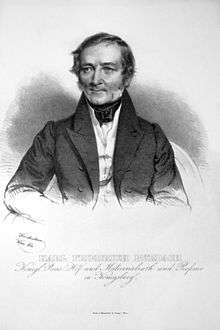Karl Friedrich Burdach

Karl Friedrich Burdach (12 June 1776 – 16 July 1847) was a German physiologist. He was born in Leipzig and died in Königsberg.
Life
He was graduated in medicine at Leipzig in 1800; became professor of physiology in the University of Dorpat in 1811, and four years later took a similar position at the University of Königsberg.
He provided in 1822 the name, due to the arching shape of its longest fibres, of the arcuate fasciculus[1][2], and in 1800 the name "Biology" in the modern sense of the term.
Burdach was an advocate of vitalism. He believed in a life force that "created the whole world and produced each living thing."[3]
Legacy
The column of Burdach or fasciculus cuneatus, the lateral portion of the dorsal funiculus of the spinal cord is named for him.[4] He differentiated the caudate nucleus from the putamen and identified the globus pallidus and its inner and outer segments.
Works
- Diatetik für Gesunde (1805)
- Enzyklopädie der Heilwissenschaft (three volumes, 1810–12)
- Vom Bau und Leben des Gehirns und Rückenmarks (three volumes, 1819–25)
- Neues Recepttaschenbuch für angehende Ärzte . 2., unveränd. Ausg. (1820) Digital edition by the University and State Library Düsseldorf
- Die Physiologie als Erfahrungswissenschaft (1826–40)
Notes
- ↑ Catani M, Mesulam M. (2008). The arcuate fasciculus and the disconnection theme in language and aphasia: history and current state. Cortex. 44(8):953-61. PMID 18614162
- ↑ Carl Friedrich Burdach (1822), Vom Baue und Leben des Gehirns, volume II, division iii, chapter iv, § 197, page 153
- ↑ Shamdasani, Sonu. (2003). Jung and the Making of Modern Psychology: The Dream of a Science. Cambridge University Press. pp. 179-180. ISBN 0-521-83145-8
- ↑ The American Illustrated Medical Dictionary, 1938.
References
